1.为什么学习string类?
1.1C语言中的字符串
C语言中,字符串是以'\0'结尾的一些字符的集合,为了操作方便,C标准库中提供了一些str系列 的库函数,但是这些库函数与字符串是分离开的,不太符合OOP的思想,而且底层空间需要用户 自己管理,稍不留神可能还会越界访问。
2.标准库中的string类
2.1string类介绍

在使用string类时,必须包含#include<string>头文件以及using namespace std;
注意:以下关于string的介绍都是讲解常用的,个别不常用的暂时不介绍了
2.2 auto与范围for
auto关键字
在早期C/C++中auto的含义是:使用auto修饰的变量,是具有自动存储器的局部变量,后来这个 不重要了。C++11中,标准委员会变废为宝赋予了auto全新的含义即:auto不再是一个存储类型指示符,而是作为一个新的类型指示符来指示编译器,auto声明的变量必须由编译器在编译时期推导而得。
用auto声明指针类型时,用auto和auto*没有任何区别 ,但用auto声明引用类型时则必须加&
当在同一行声明多个变量时,这些变量必须是相同的类型,否则编译器将会报错,因为编译器实际 只对第一个类型进行推导,然后用推导出来的类型定义其他变量。
auto不能作为函数的参数,可以做返回值,但是建议谨慎使用
auto不能直接用来声明数组
cpp
//auto 自动推导类型
auto x = 10;
auto y = 10.1;
cout << x << endl;
cout << y << endl;
//声明引用
int& z = x;
//auto m = z;
auto& m = z;//引用
m++;
//声明指针无区别
auto p1 = &x;
auto* p2 = &x;
auto aa = 1, bb = 2;
// 编译报错:error C3538: 在声明符列表中,"auto"必须始终推导为同一类型
auto cc = 3, dd = 4.0;
// 不能做参数
void func2(auto a)
{}
// 可以做返回值,但是建议谨慎使用
auto func3()
{
return 3;
}auto在c++中是一个非常便捷的工具,可以用他简化代码
cpp
#include<iostream>
#include <string>
#include <map>
using namespace std;
int main()
{
std::map<std::string, std::string> dict = { { "apple", "苹果" },{ "orange",
"橙子" }, {"pear","梨"} };
// auto
//std::map<std::string, std::string>::iterator it = dict.begin();
auto it = dict.begin();
while (it != dict.end())
{
cout << it->first << ":" << it->second << endl;
++it;
}
return 0;
}范围for
- 对于一个有范围的集合 而言,由程序员来说明循环的范围是多余的,有时候还会容易犯错误。因此 C++11中引入了基于范围的for循环。for循环后的括号由冒号" :"分为两部分 :第一部分是范围内用于迭代的变量,第二部分则表示被迭代的范围,自动迭代,自动取数据,自动判断结束。
- 范围for可以作用到数组和容器对象上进行遍历
- 范围for的底层很简单,容器遍历实际就是替换为迭代器,这个从汇编层也可以看到。
cpp
//自动取容器数据 赋值给ch
//自动判断结束
//自动迭代
//本质底层也会替换成迭代器,auto e = *迭代器
int main()
{
int array[] = { 1, 2, 3, 4, 5 };
// C++98的遍历
for (int i = 0; i < sizeof(array) / sizeof(array[0]); ++i)
{
array[i] *= 2;
}
for (int i = 0; i < sizeof(array) / sizeof(array[0]); ++i)
{
cout << array[i] << endl;
}
// C++11的遍历
for (auto& e : array)
e *= 2;
for (auto e : array)
cout << e << " " << endl;
string str("hello world");
for (auto ch : str)
{
cout << ch << " ";
}
cout << endl;
return 0;
}2.3string的常用接口
2.3.1string类对象的常见构造

cpp
string s1; //构造对象
string s2("Hello world"); //调用构造函数初始化
string s3(s2); //复制
string s4(s2, 1, 6); //复制s2中第1个字符至第六个(下标从0开始)
string s5(s2, 3, 60); //同上,当s2不足60个字符时,自动暂停
string s6(s2, 1); //从s2的第一位开始复制
const char* str = "hello world";
string s7(str, 5); //复制str字符串的前5个字符
string s8(100, '#'); //复制100个字符'#'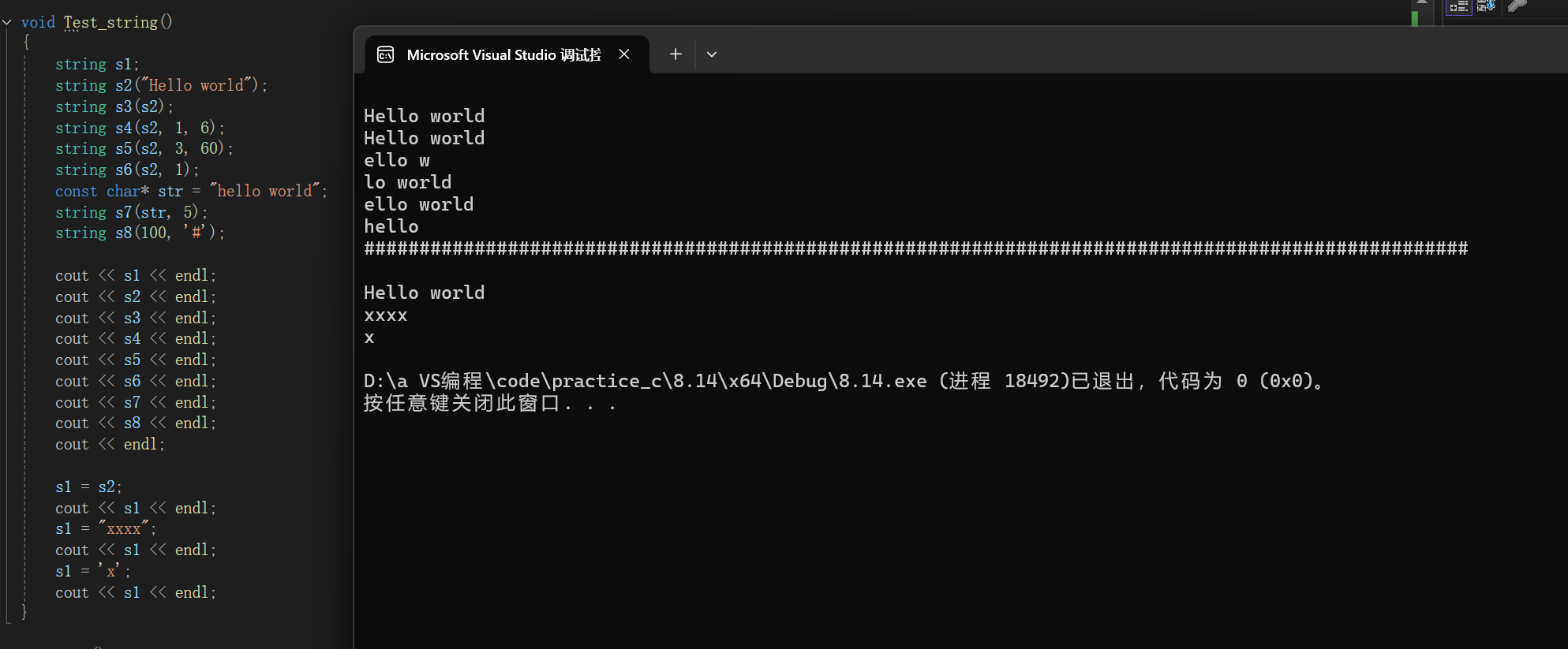
2.3.2string类对象的容量操作

cpp
int main()
{
string s;
int n = 100;
s.size(); //返回字符串有效字符长度
s.length(); //返回字符串有效字符长度
s.capacity(); //返回空间总大小
s.empty(); //检测字符串释放为空串,是返回true,否则返回false
s.clear(); //清空有效字符
s.reserve(); //为字符串预留空间**
s.resize(n,'c'); //将有效字符的个数该成n个,多出的空间用字符c填充
return 0;
}注意:
1.size()与length()方法底层实现原理完全相同,引入size()的原因是为了与其他容器的接口保持一致,一般情况下基本都是用size()。
clear()只是将string中有效字符清空,不改变底层空间大小。
resize(size_t n) 与 resize(size_t n, char c)都是将字符串中有效字符个数改变到n个,不同的是当字符个数增多时:resize(n)用0来填充多出的元素空间,resize(size_t n, char c)用字符c来填充多出的元素空间。注意:resize在改变元素个数时,如果是将元素个数 增多,可能会改变底层容量的大小,如果是将元素个数减少,底层空间总大小不变。
reserve(size_t res_arg=0):为string预留空间,不改变有效元素个数,当reserve的参 数小于string的底层空间总大小时,reserver不会改变容量大小。
容量的查找等:
cpp
void test_string04()
{
string s1("12345");
cout << s1.max_size() << endl;//返回能储存的最大数据,知道干啥的就行(没啥用)
//size()与capacity()均不包含"\0"
cout << s1.size() << endl;
cout << s1.capacity() << endl;
string s2;
size_t old = s2.capacity();
cout << "old capacity:" << old << endl;
for (size_t i = 0; i < 100; i++)
{
s2.push_back('x');
if (s2.capacity() != old)
{
cout << "capacity:" << s2.capacity() << endl;
old = s2.capacity();
}
}
//不会缩容
cout <<"empty:" << s1.empty() << endl;
cout << "size:" << s1.size() << endl;
cout << "capacity:" << s1.capacity() << endl;
cout << s1 << endl;
s1.clear();
cout << s1 << endl;
cout <<"empty:" << s1.empty() << endl;
cout <<"size:"<< s1.size() << endl;
cout << "capacity:" << s1.capacity() << endl;
//不会缩容
cout <<"empty:" << s2.empty() << endl;
cout << "size:" << s2.size() << endl;
cout << "capacity:" << s2.capacity() << endl;
cout << s2 << endl;
//s2.clear();
for (size_t i = 0; i < 100; i++)
{
s2.pop_back();
}
cout << s2 << endl;
cout <<"empty:" << s2.empty() << endl;
cout <<"size:"<< s2.size() << endl;
cout << "capacity:" << s2.capacity() << endl;
}string在push_back时会自动扩容,扩容的规律根据编译平台变换。
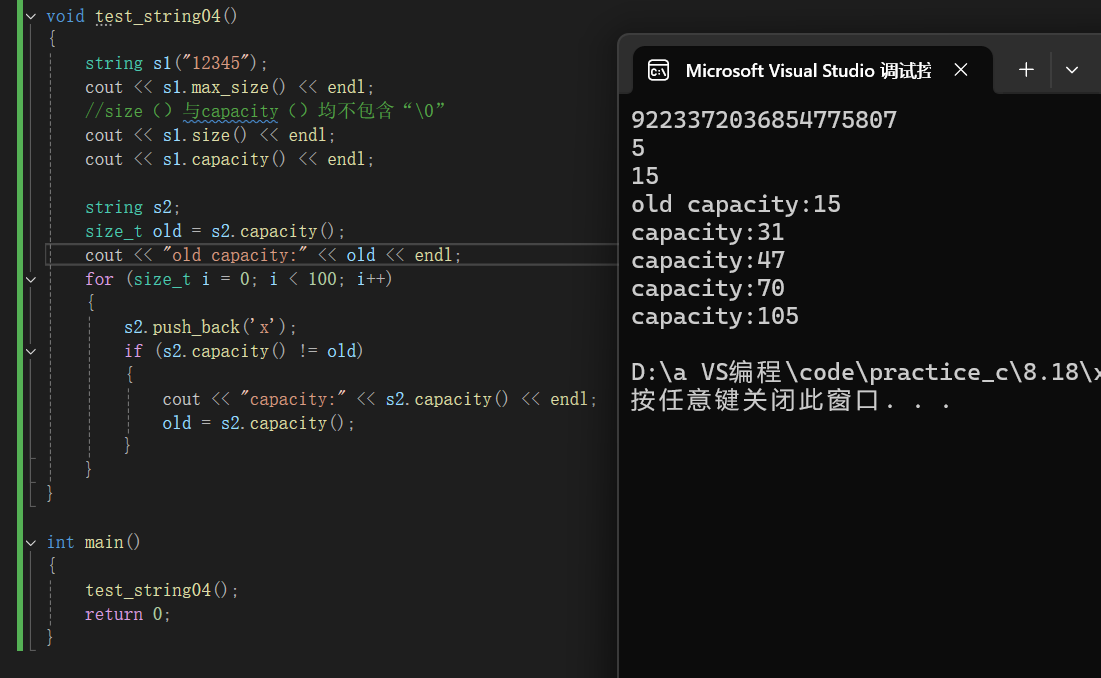
通过测试发现,clear并不会把原字符串的内存容量删掉,而是把size值清空。

pop_back也一样。通过改变size值达到删除数据的效果。
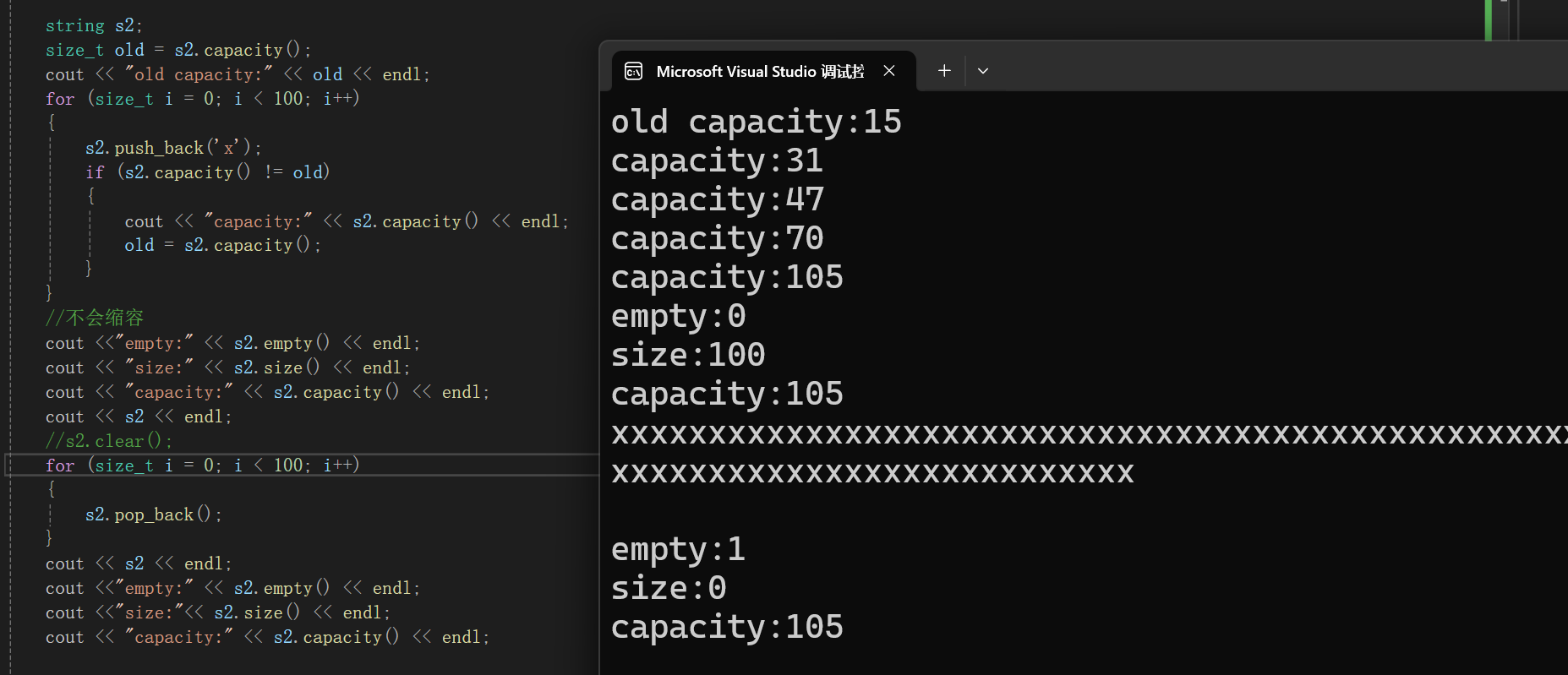
容量的修改:
这里要注意区分:
reserve 储备 保留
reverse 反转 逆置
capacity的修改:
cpp
void test_string05()
{
string s1("123456");
cout << "size:" << s1.size() << endl;
cout << "capacity:" << s1.capacity() << endl;
//主要用来扩容 提高效率(确定需要多少空间)
s1.reserve(100);
cout << "size:" << s1.size() << endl;
cout << "capacity:" << s1.capacity() << endl<<endl;
s1.reserve(10);
cout << "size:" << s1.size() << endl;
cout << "capacity:" << s1.capacity() << endl;
//缩容不靠谱
s1.reserve(3);
cout << "size:" << s1.size() << endl;
cout << "capacity:" << s1.capacity() << endl;
}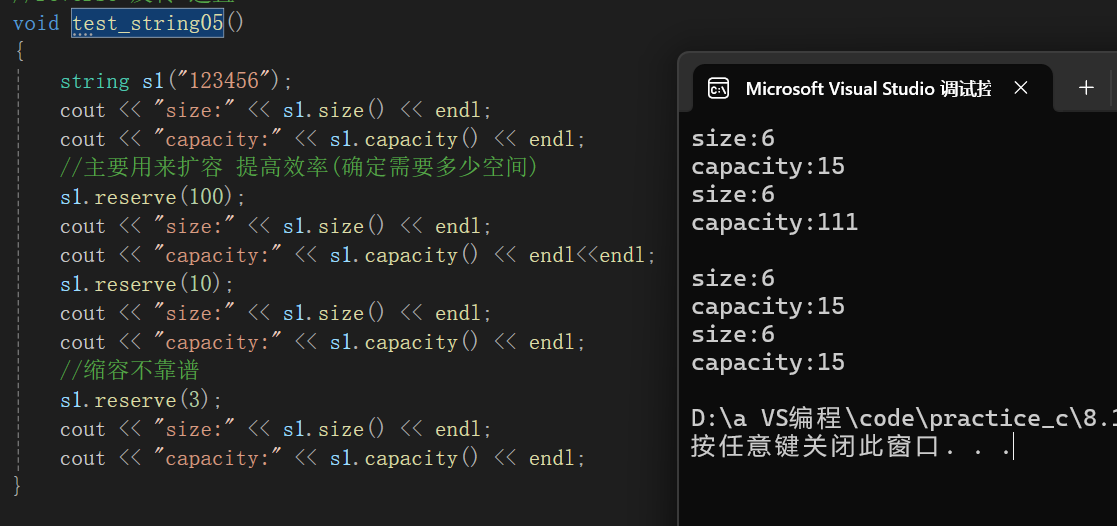
size的修改:
在修改size时,capacity也会随之变动。
cpp
void test_string06()
{
string s1("123456");
cout << "size:" << s1.size() << endl;
cout << "capacity:" << s1.capacity() << endl<<endl;
//n>capacity>size
s1.resize(20,'x');
cout << "size:" << s1.size() << endl;
cout << "capacity:" << s1.capacity() << endl;
//capacity>n>capacity
s1.resize(25,'x');
cout << "size:" << s1.size() << endl;
cout << "capacity:" << s1.capacity() << endl;
//capacity>n>capacity
s1.resize(25,'x');//插入的是\0
s1.push_back('y');
cout << "size:" << s1.size() << endl;
cout << "capacity:" << s1.capacity() << endl;
}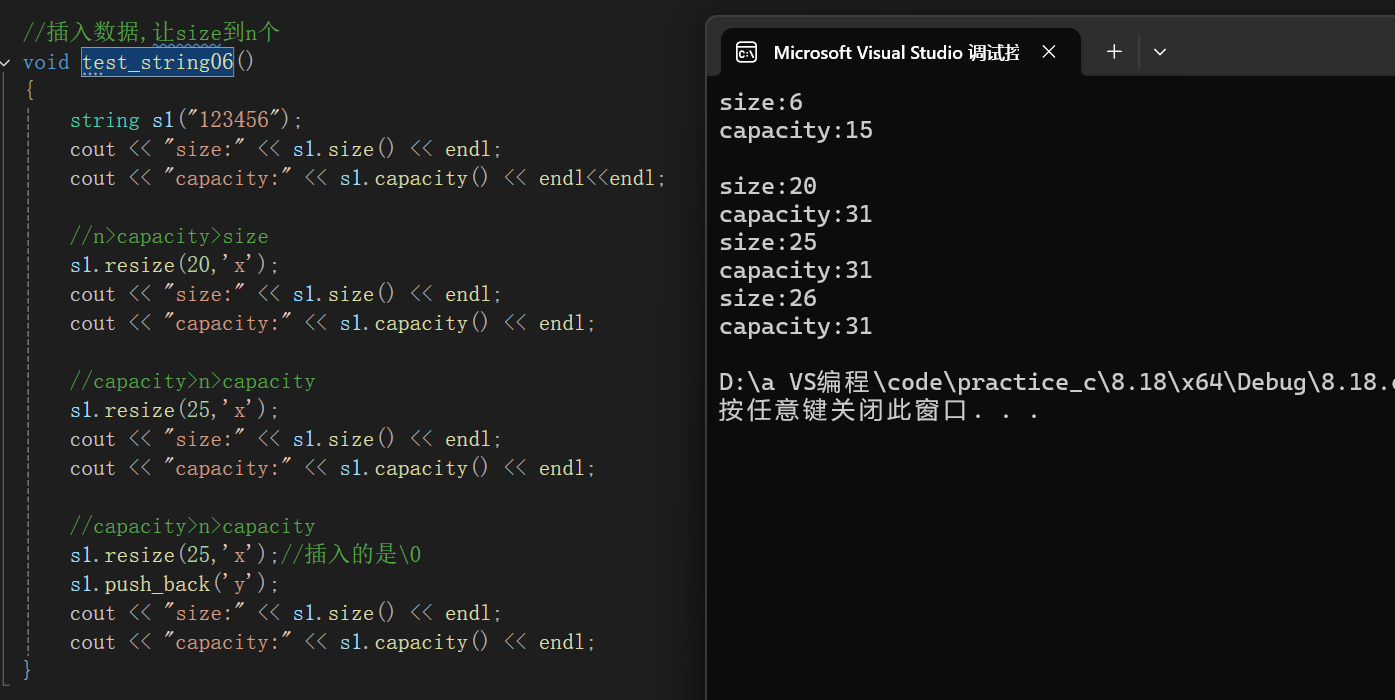
2.3.3string类对象的访问及遍历操作
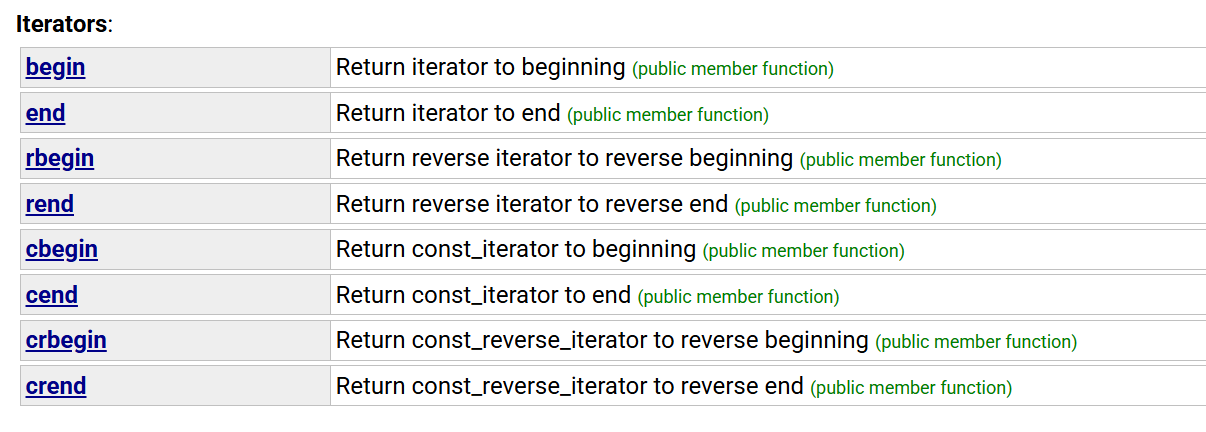
c++中引入的迭代器是一个非常重要的工具,它就相当于各大容器的指针。
那么先了解一下最普通的:
cppstring s1("Hello world"); int pos = 1; s1[pos]; //返回pos位置的字符,const string类对象调用 s1.begin();//begin获取一个字符的迭代器 s1.end(); //end获取最后一个字符下一个位置的迭代器
cpp
void Test_string02()
{
string s1("Hello world");
const string s2("Hello world");
//遍历+修改
//下标 + [ ](小众)
s1[0]++; //s1.operator[](0)++
cout << s1 << endl;
// s1的每个字符都++
for (int i = 0; i < s1.size(); i++)
{
s1[i]++;
}
cout << s1 << endl;
//[begin(),end())
//迭代器(所有容器主流的编译方式)
// s1的每个字符都--
string::iterator it1 = s1.begin();
while (it1 != s1.end())
{
(*it1)--;//修改内部数据
it1++; //迭代器往后走
}
cout << s1 << endl;
cout << endl;
//数据结构--动态顺序表
vector<int>v;
v.push_back(1);
v.push_back(2);
v.push_back(3);
v.push_back(4);
vector<int>::iterator it2 = v.begin();
while (it2 != v.end())
{
cout << *it2 << ' ';
it2++;
}
cout << endl;
//数据结构--链表
list<int>lt;
lt.push_back(1);
lt.push_back(2);
lt.push_back(3);
list<int>::iterator it3 = lt.begin();
while (it3 != lt.end())
{
cout << *it3 << ' ';
it3++;
}
cout << endl;
//迭代器的意义
//1:统一类似的方式遍历修改容器
//2:算法脱离具体底层结构,和底层结构解耦
//迭代器做参数
reverse(s1.begin(), s1.end());//反转函数,目前认识即可
reverse(v.begin(), v.end());
reverse(lt.begin(), lt.end());
//同时可以配合范围for使用
//自动取容器数据 赋值给ch
//自动判断结束
//自动迭代
//本质底层也会替换成迭代器,auto e = *迭代器
for (auto& e : s1)
{
e--;
}
for (auto ch : s1)
{
cout << ch << " ";
}
cout << endl;
for (auto ch : v)
{
cout << ch << " ";
}
cout << endl;
for (auto ch : lt)
{
cout << ch << " ";
}
cout << endl;
int array[] = { 1,2,3,4,5 };
for (auto e : array)
{
cout << e << " ";
}
cout << endl;
}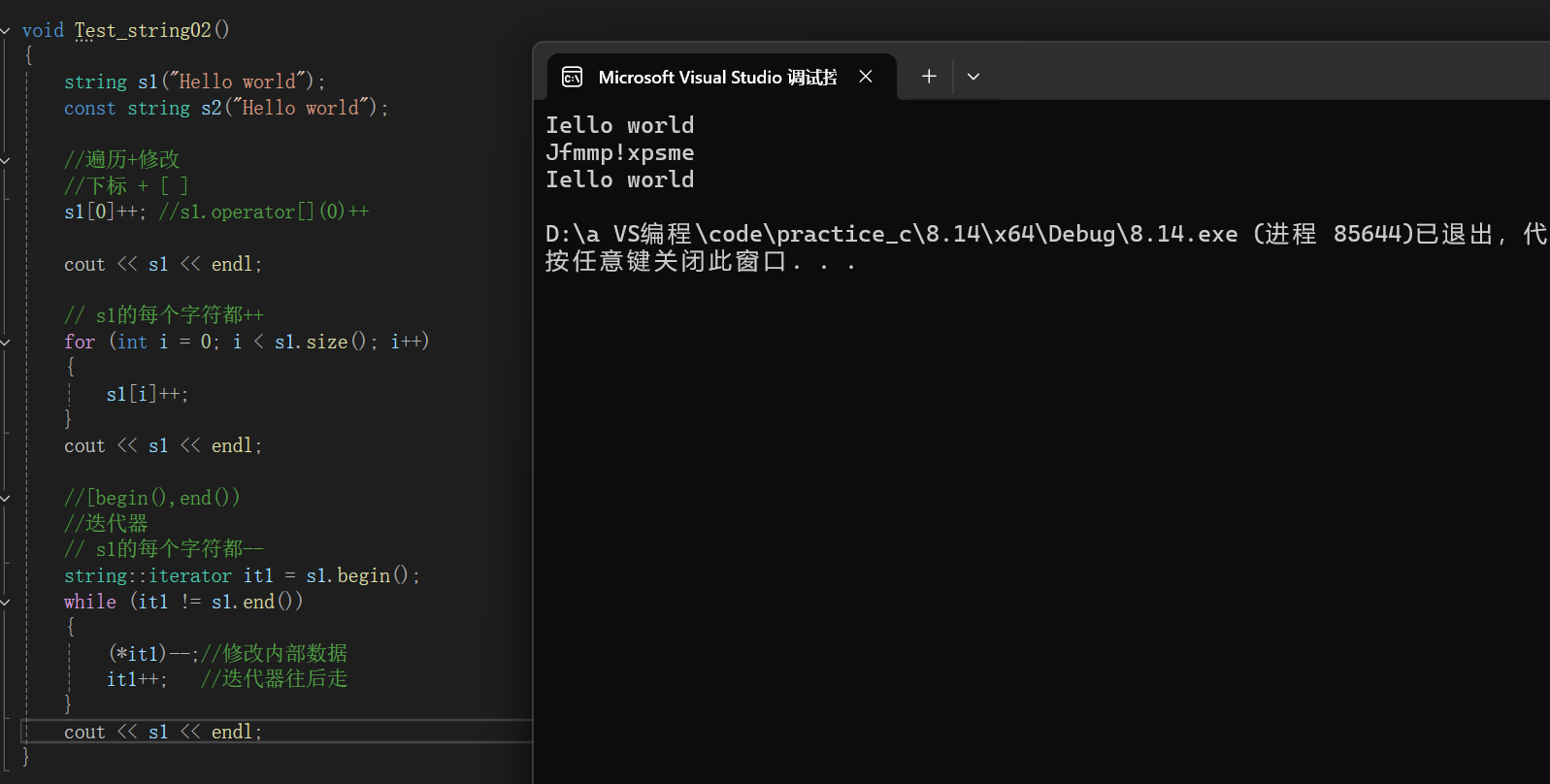
除此之外,还有比较特殊的迭代器,可以用于不同的情况。
cpp
void test_string03()
{
string s1("123456");
const string s2("Hello world");
string::iterator it1 = s1.begin();//普通正向迭代器
while (it1 != s1.end())
{
(*it1)--;
it1++;
}
cout << s1;
cout << endl;
string::const_iterator it2 = s2.begin();//const迭代器
//string::const_iterator it2 = s2.cbegin();//const迭代器
while (it2 != s2.end())
{
//(*it2)--;不能修改
++it2;
}
cout << s2;
cout << endl;
string::reverse_iterator it3 = s1.rbegin();//反向迭代器
while (it3 != s1.rend())
{
cout << *it3 << " ";
it3++;
}
cout << endl;
string::const_reverse_iterator it4 = s2.crbegin();//const反向迭代器
while (it4 != s2.crend())
{
//不能修改
//*it4 = 'x';
cout << *it4 << " ";
it4++;
}
cout << endl;
}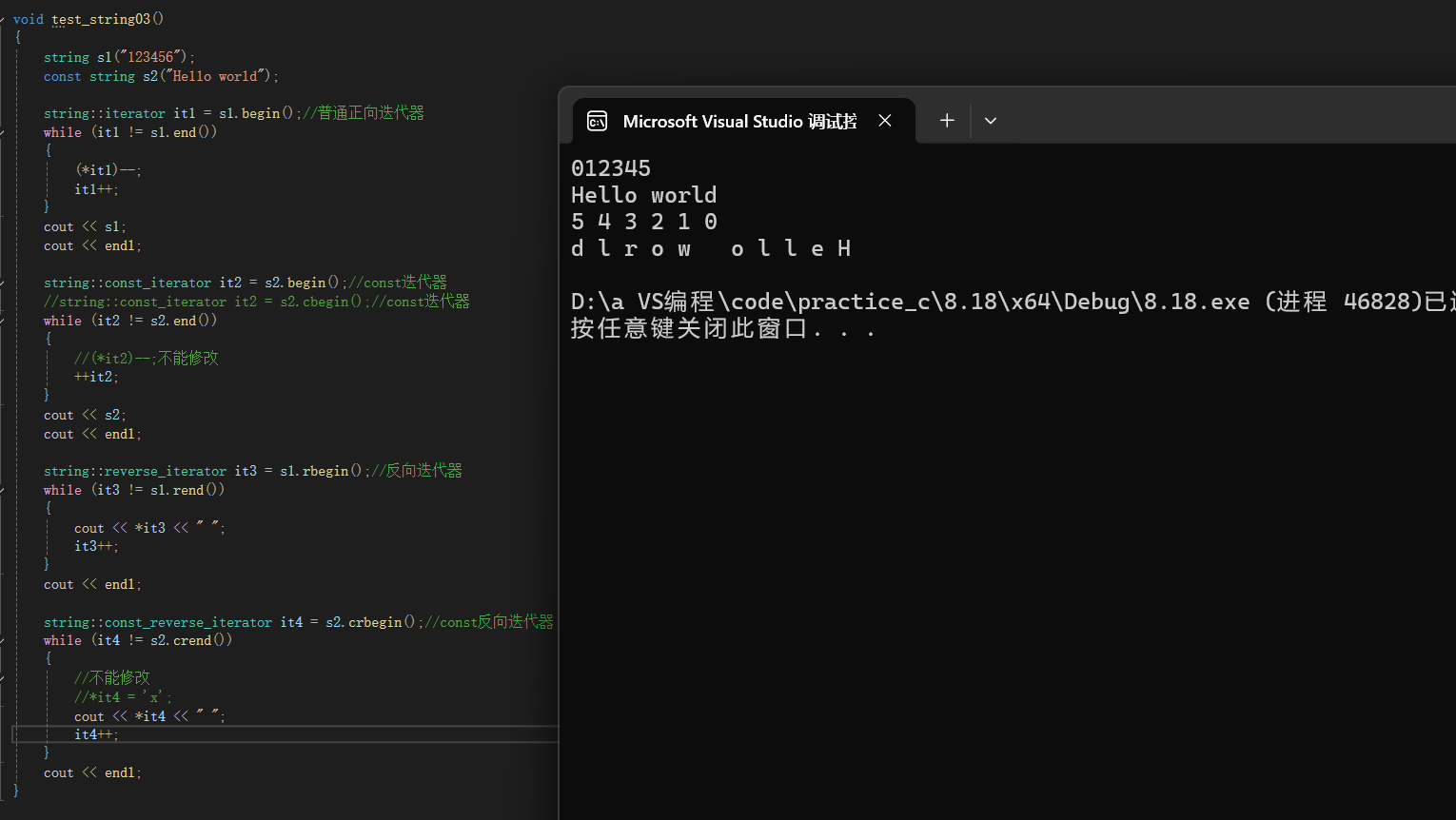
2.3.4string类对象的修改操作
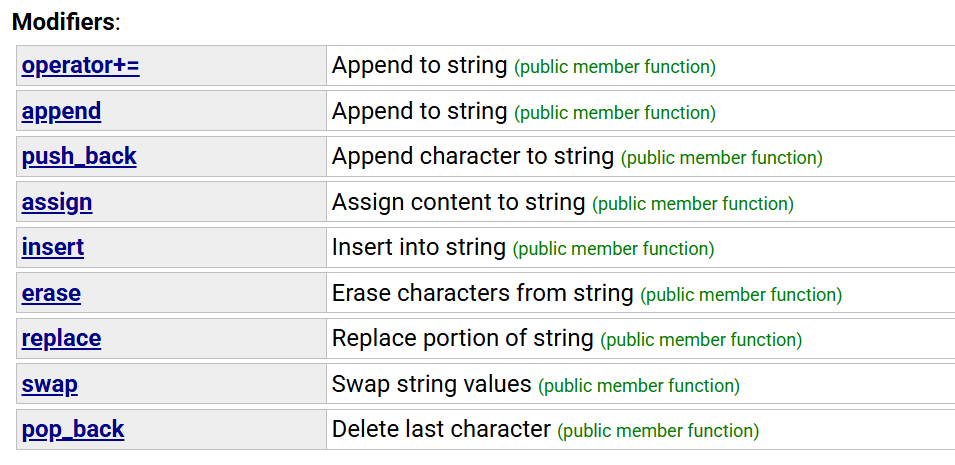
注意:
在string尾部追加字符时,s.push_back(c) / s.append(1, c) / s += 'c'三种的实现方式差 不多,一般情况下string类的+=操作用的比较多,+=操作不仅可以连接单个字符,还可以连接字符串。
对string操作时,如果能够大概预估到放多少字符,可以先通过reserve把空间预留好。
cppint main() { string s; s.push_back('1');//在字符串后尾插字符c s += "23"; //在字符串后追加一个字符串 s.append("45"); //在字符串后追加字符串str }
在尾部添加字符时更常用"+=" 它不仅方便,而且还同时支持字符与字符串
cpp
int main()
{
//在尾部加字符
string s1("Hello World");
s1.push_back(' ');
s1.append("hello bit");
s1.append(10,'x');
s1 += ' ';
s1 += "hello";
cout << s1 << endl << endl;
return 0;
}
对于字符串中间的修改:
cppint mian() { string s; s.assign(); //赋值操作 s.insert(); //从字符串中间插入字符串 s.erase(); //从字符串中删除字符 s.replace();//指定位置替换操作 }
cpp
void test_string08()
{
string s1 = 'X';
cout << s1 << endl;
s1.assign(10, 'x');//赋值
cout << s1 << endl;
//insert 插入字符串
//insert谨慎使用 底层数据挪动,效率低下,O(N);
string s2("Hello World");
s2.insert(0, "yyy");
cout << s2 << endl;
s2.insert(0, 1, '!');
cout << s2 << endl;
s2.insert(s2.begin(), '!');
cout << s2 << endl<<endl;
string s3("hello Wolrd");
s3.erase(5, 1);//第五个位置删一个字符
cout << s3 << endl;
s3.erase(5);//第五个位置后全部删除
cout << s3 << endl << endl;
string s4("hello Wolrd");
s4.replace(5, 1, "#");//第五位 替换一个
cout << s4 << endl;
s4.replace(5, 3, "#");//从第五位三个字符替换成"#"
cout << s4 << endl;
s4.replace(5, 1, "!!!!");//从第五位1个字符替换成"!!!!"
cout << s4 << endl << endl;
}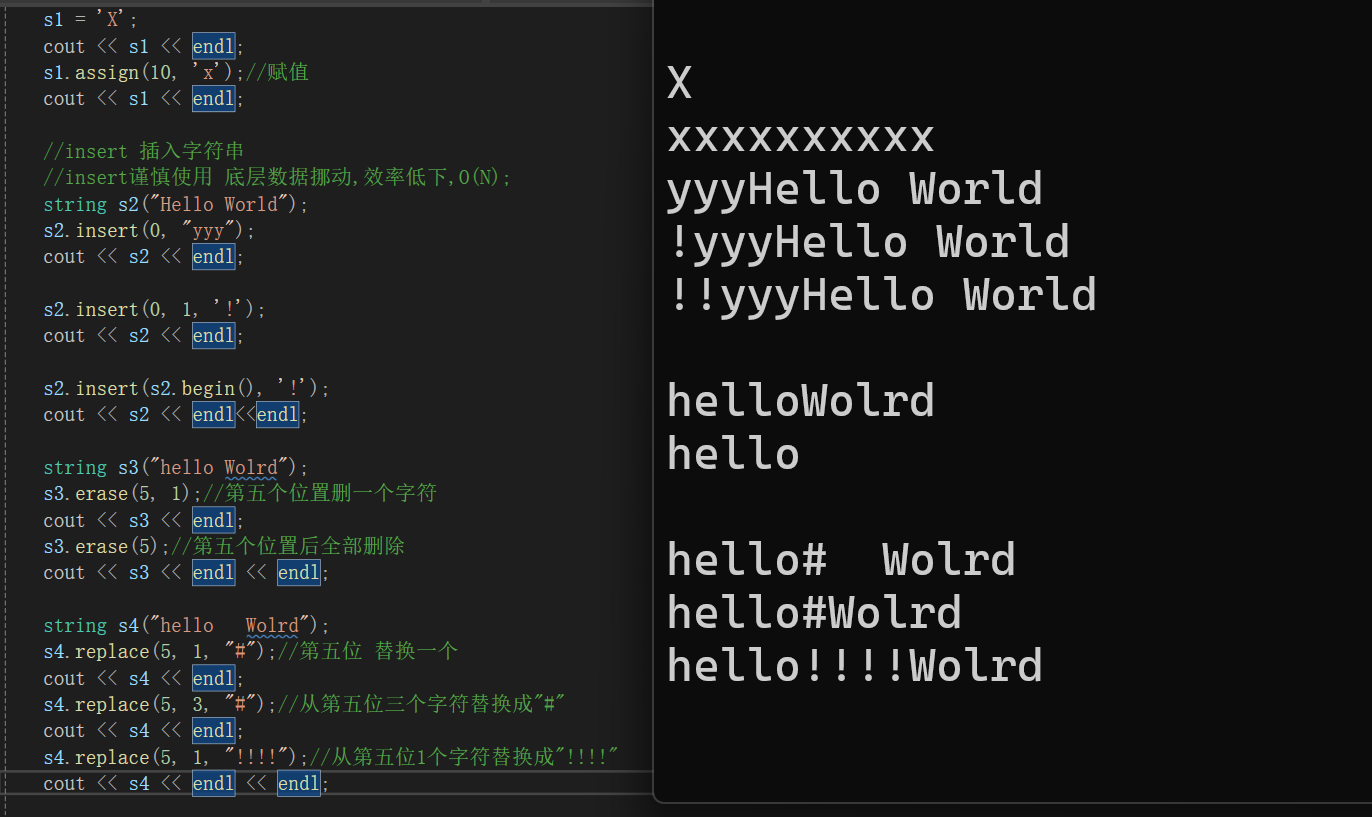
除了对字符串的修改,还提供了具有"查找"功能的工具。
cppint mian() { string s; s.c_str(); //返回C格式字符串 s.find(1);//从字符串pos位置开始往后找字符c,返回该字符在字符串中的位置 s.rfind(2); //从字符串pos位置开始往前找字符c,返回该字符在字符串中的位置 s.substr(0, 2);//在str中从pos位置开始,截取n个字符,然后将其返回 }
cpp
void test_string04()
{
//把空格全部替换成%%
string s5("Hello World Hello XiaoHai");
//法一:
size_t pos = s5.find(' ');//从起始开始返回第一个字符为' '的位置.
while (pos != string::npos)//静态成员变量
{
s5.replace(pos, 1, "%%");
pos = s5.find(' ',pos+2);
}
cout << s5 << endl;
//法二:
string s6;
for (auto ch:s5)
{
if (ch == ' ')
{
s6 += "%%";
}
else
{
s6 += ch;
}
}
cout << s6;
}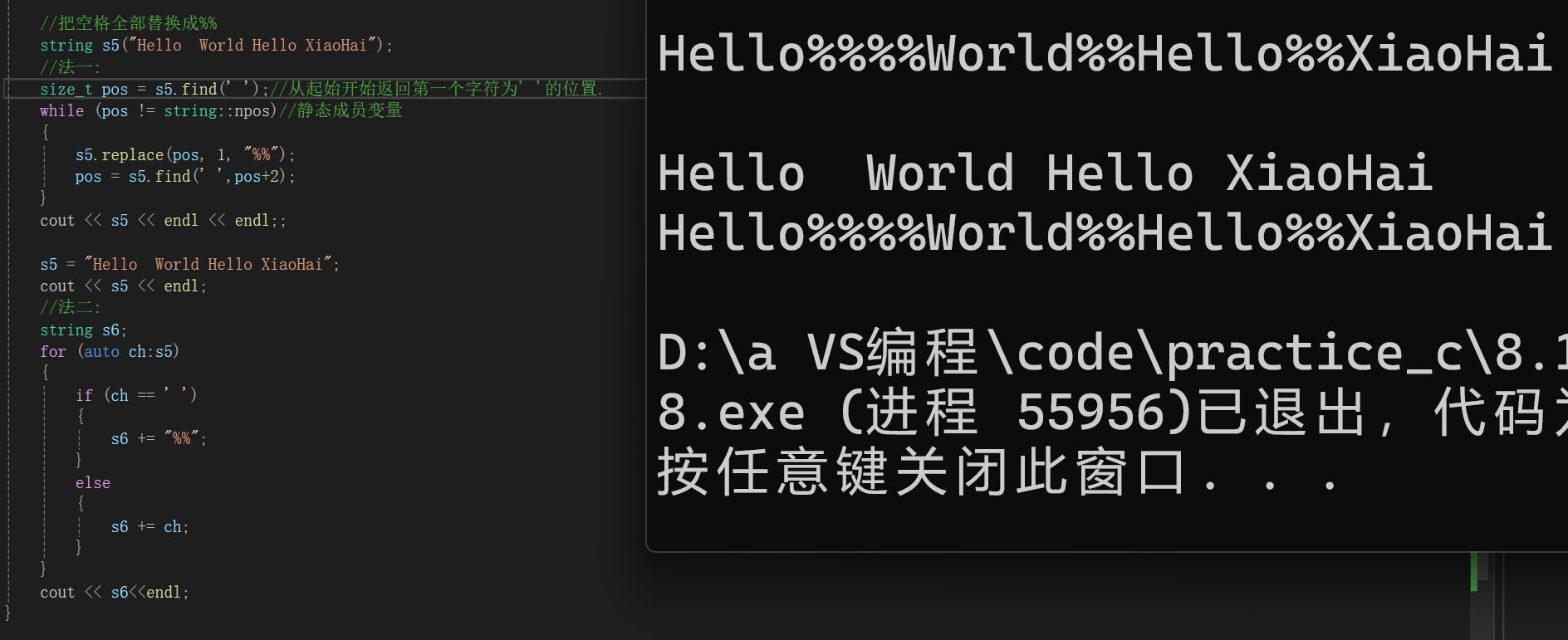
2.3.5string类非成员函数

cpp
int main()
{
string s;
cin >> s;//输入运算符重载
s + "wolrd";
cout << s;//输出运算符重载
string name;
cout << "请输入名字: ";
std::getline(std::cin, name);//获取一行字符串
cout<<"hello:"<< name << "\n";
string s1 = "hello";
string s2 = "hellox";
cout << (s1<s2) << endl;
cout << (s1>s2) << endl;
cout << (s1<=s2) << endl;
cout << (s1>=s2) << endl;
cout << (s1==s2) << endl;
cout << (s1!=s2) << endl;
return 0;
}3.string类型的实现
3.1经典的string类问题
cpp
class String
{
public:
/*String()
:_str(new char[1])
{*_str = '\0';}
*/
//String(const char* str = "\0") 错误示范
//String(const char* str = nullptr) 错误示范
String(const char* str = "")
{
// 构造String类对象时,如果传递nullptr指针,可以认为程序非
if (nullptr == str)
{
assert(false);
return;
}
_str = new char[strlen(str) + 1];
strcpy(_str, str);
}
~String()
{
if (_str)
{
delete[] _str;
_str = nullptr;
}
}
private:
char* _str;
};
// 测试
void TestString()
{
String s1("hello bit!!!");
String s2(s1);
}说明:上述String类没有显式定义其拷贝构造函数与赋值运算符重载,此时编译器会合成默认 的,当用s1构造s2时,编译器会调用默认的拷贝构造。最终导致的问题是,s1、s2共用同一块内 存空间,在释放时同一块空间被释放多次而引起程序崩溃,这种拷贝方式,称为浅拷贝。
3.2浅拷贝:
浅拷贝:也称位拷贝,编译器只是将对象中的值拷贝过来。如果对象中管理资源,最后就会导致 多个对象共享同一份资源,当一个对象销毁时就会将该资源释放掉,而此时另一些对象不知道该 资源已经被释放,以为还有效,所以当继续对资源进项操作时,就会发生发生了访问违规。
3.3深拷贝:
如果一个类中涉及到资源的管理,其拷贝构造函数、赋值运算符重载以及析构函数必须要显式给 出。一般情况都是按照深拷贝方式提供。
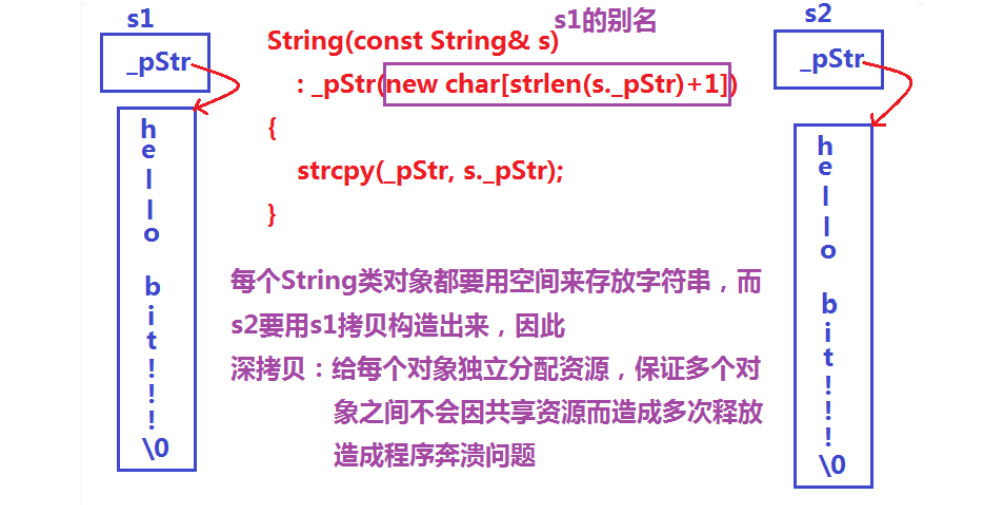
3.4接口实现:
3.4.1string.h:
cpp
//string.h
#pragma once
#include<iostream>
#include<string.h>
#include<assert.h>
using namespace std;
namespace XiaoHai
{
class string
{
public:
typedef char* iterator;
typedef const char* const_iterator;
iterator begin();
iterator end();
const_iterator begin() const;
const_iterator end() const;
//string();
string(const char* str = "");
const char* c_str() const;
~string();
string(const string& s);
size_t size() const;
const char& operator[](size_t i)const;
char& operator[](size_t i);
void reserve(size_t n);
//插入
void push_back(char ch);
void append(const char* str);
string& operator+=(char ch);
string& operator+=(const char* str);
string& insert(size_t pos, char ch);
string& insert(size_t pos,const char*str);
string& erase(size_t pos, size_t len = npos);
void pop_back();
size_t find(char ch, size_t pos = 0) const;
size_t find(const char* str, size_t pos=0) const;
string substr(size_t pos, size_t len = npos) const;
bool operator<(const string& s) const;
bool operator<=(const string& s) const;
bool operator>(const string& s) const;
bool operator>=(const string& s) const;
bool operator==(const string& s) const;
bool operator!=(const string& s) const;
void clear();
private:
char* _str;
size_t _size;
size_t _capacity;
public:
static const size_t npos;
};
ostream& operator<<(ostream& out, const string& s);
istream& operator>>(istream& in, string& s);
}3.4.2string.cpp:
cpp
//string.cpp
#include"string.h"
namespace XiaoHai
{
//string::string()
// :_str(new char[1]{'\0'})
// ,_size(0)
// ,_capacity(0)
//{ }
string::string(const char* str)
:_str(new char[strlen(str) + 1])
, _size(strlen(str))
,_capacity(strlen(str))
{
memcpy(_str, str, _size + 1);
}
string::~string()
{
delete[] _str;
_str = nullptr;
_size = _capacity = 0;
}
string::string(const string& s)
{
_str = new char[s._capacity + 1];
memcpy(_str, s._str, s._size + 1);
_size = s._size;
_capacity = s._capacity;
}
const char* string::c_str() const
{
return _str;
}
size_t string::size() const
{
return _size;
}
const char& string::operator[](size_t i)const
{
assert(i < _size);
return _str[i];
}
char& string::operator[](size_t i)
{
assert(i < _size);
return _str[i];
}
string::iterator string::begin()
{
return _str;
}
string::iterator string::end()
{
return _str + _size;
}
string::const_iterator string::begin()const
{
return _str;
}
string::const_iterator string::end()const
{
return _str + _size;
}
void string::reserve(size_t n)
{
if (n > _capacity)
{
char* str = new char[n + 1];
//strcpy(str, _str);
//memcpy(_str,str, _size + 1);
memcpy(str,_str, _size + 1);
delete[] _str;
_str = str;
_capacity = n;
}
}
//插入
void string::push_back(char ch)
{
if (_size >= _capacity)
{
size_t newcapacity = _capacity == 0 ? 4 : 2 * _capacity;
reserve(newcapacity);
}
if (ch != '\0')
{
_str[_size] = ch;
++_size;
_str[_size] = '\0';
}
}
void string::append(const char* str)
{
size_t len = strlen(str);
if (_size + len>_capacity)
{
size_t newcapacity = 2 * _capacity > _size + len ? 2 * _capacity : _size + len;
reserve(newcapacity);
}
//strcpy(_str+_size, str);
memcpy(_str+_size, str, len + 1);
_size += len;
}
string& string::operator+=(char ch)
{
push_back(ch);
return *this;
}
string& string::operator+=(const char* str)
{
append(str);
return *this;
}
string& string::insert(size_t pos, char ch)
{
assert(pos <= _size);
if (_size>= _capacity)
{
size_t newcapacity = _capacity == 0 ? 4 : 2 * _capacity;
reserve(newcapacity);
}
//挪动数据
//size_t end = _size;
/*while (end>=(int)pos)
{
_str[end + 1] = _str[end];
--end;
}*/
size_t end = _size+1;
while (end>pos)
{
_str[end] = _str[end-1];
--end;
}
_str[pos] = ch;
++_size;
return *this;
}
string& string::insert(size_t pos, const char*str)
{
assert(pos <= _size);
size_t len = strlen(str);
if (_size + len > _capacity)
{
size_t newcapacity = 2 * _capacity > _size + len ? 2 * _capacity : _size + len;
reserve(newcapacity);
}
/*int end = _size;
while (end >= (int)pos)
{
_str[end + len] = _str[end];
--end;
}*/
int end = _size+len;
while (end >pos+len-1)
{
_str[end] = _str[end-len];
--end;
}
for (size_t i = 0; i < len; i++)
{
_str[pos + i] = str[i];
}
_size += len;
return *this;
}
string& string::erase(size_t pos, size_t len)
{
assert(pos < _size);
//要删除的数据,大于pos后面的字符个数
//pos后面全删
if (len==npos||len>=(_size-pos))
{
_size = pos;
_str[_size] = '\0';
}
else
{
size_t i = pos + len;
memmove(_str + pos, _str + i, _size + 1 - i);
_size -= len;
}
return *this;
}
void string::pop_back()
{
assert(_size > 0);
--_size;
_str[_size] = '\0';
}
size_t string::find(char ch, size_t pos)const
{
for (size_t i = pos; i < i<_size; i++)
{
if (_str[i]==ch) {
return i;
}
}
}
size_t string::find(const char* str, size_t pos)const
{
//kmp
const char* p1 = strstr(_str + pos, str);
if (p1 == nullptr)
{
return npos;
}
else
{
return p1 - _str;
}
}
string string::substr(size_t pos, size_t len) const
{
if (len == npos || len >= _size - pos)
{
len = _size - pos;
}
string ret;
ret.reserve(len);
for (size_t i = 0; i < len; i++)
{
ret += _str[pos + i];
}
return ret;
}
bool string::operator<(const string& s) const
{
rsize_t i1 = 0, i2 = 0;
while (i1<_size&&i2<s._size)
{
if (_str[i1] < s[i2])
{
return true;
}
else if (_str[i1]>s[i2])
{
return false;
}
else
{
++i1;
++i2;
}
}
return i2 < s._size;
}
bool string::operator<=(const string& s) const
{
return *this < s || *this == s;
}
bool string::operator>(const string& s) const
{
return !(*this <= s);
}
bool string::operator>=(const string& s) const
{
return !(*this < s);
}
bool string::operator==(const string& s) const
{
rsize_t i1 = 0, i2 = 0;
while (i1 < _size && i2 < s._size)
{
if (_str[i1] != s[i2])
{
return false;
}
else
{
++i1;
++i2;
}
}
return i1 == _size && i2 == s._size;
}
bool string::operator!=(const string& s) const
{
return !(*this == s);
}
void string::clear()
{
_str[0] = '\0';
_size = 0;
}
ostream& operator<<(ostream& out, const string& s)
{
//out << s.c_str();
for (size_t i = 0; i < s.size(); i++)
{
out << s[i];
}
return out;
}
istream& operator>>(istream& in, string& s)
{
s.clear();
char buff[128];
int i = 0;
char ch = _cin.get();
while (ch != '\n' && ch != ' ')
{
buff[i] = ch;
if (i == 127)
{
buff[i] = '\0';
s += buff;
i = 0;
}
ch = _cin.get();
i++;
}
if (i > 0)
{
buff[i] = '\0';
s += buff;
}
return _cin;
}
const size_t XiaoHai::string::npos = -1;
}4.类型转换
4.1其他类型转string
c++中引用了新的函数to_string(),可以把其他类型转化为string字符串
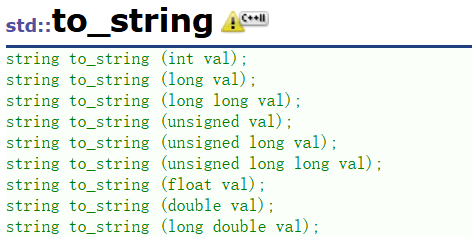
4.2string转为其他类型

调用对应的函数即可把string转化为其他类型,比如stoi()就是string to int,转化为整数类型。
